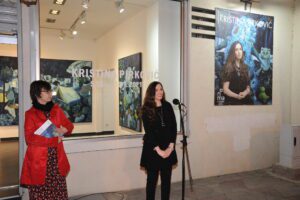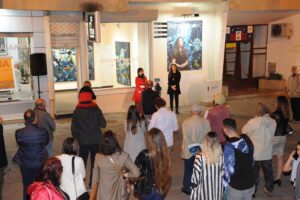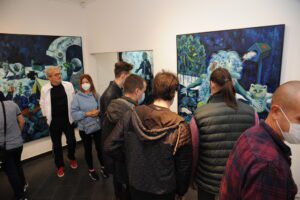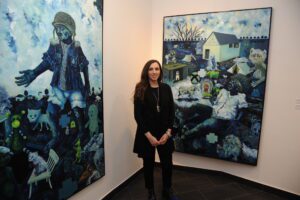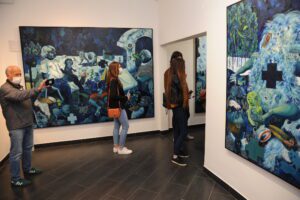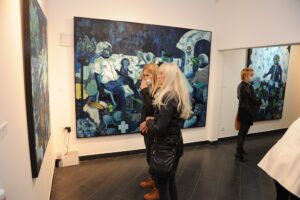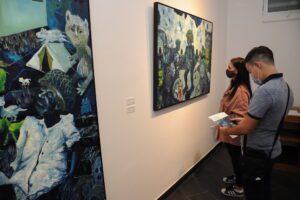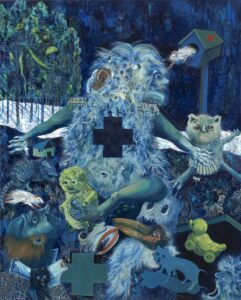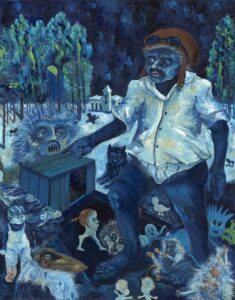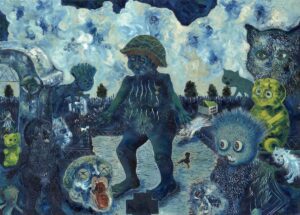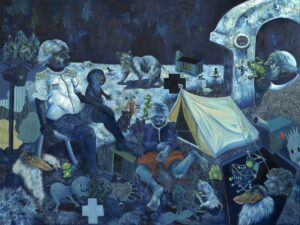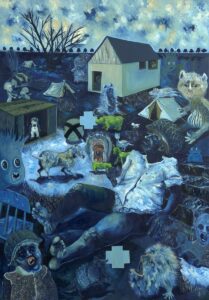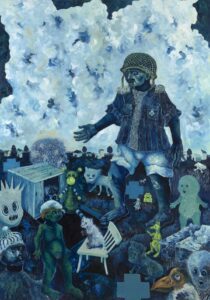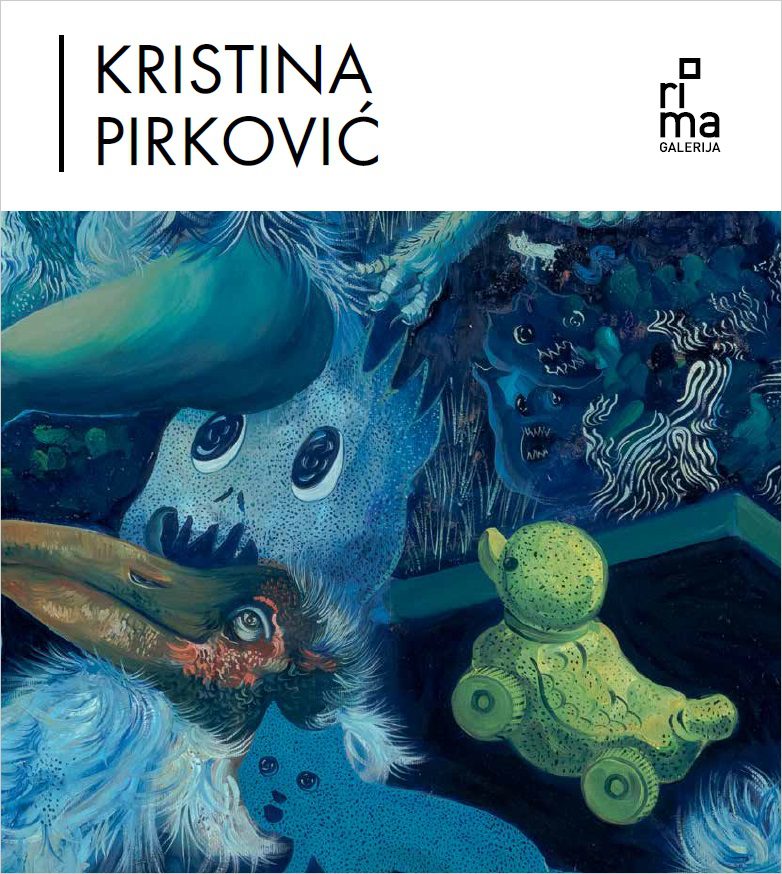Srđan Vučinić
AND HOW TO OVERCOME THE MAN
Is there still a borderline between the living and inanimate world? Can the mortal body and life be differentiated from their perfect, holographic or silicon imitations? Or, have they been forever coupled, combined to an irrecognisable state within the present moment when cybernetics and robotics have been paired with biology and medicine, while the current and future cataclysms have been introduced into the dream about redemption and further progress of humanity? These are only some of the questions that spontaneously impose themselves in front of the paintings by Kristina Perković and in them, human faces and figures are resolutely transformed into puppets and monuments, picturesque monsters and souvenirs of horror. The legions of scarecrows, toy-soldiers, but also bogeymen of nightmares wake up and spring to life, as if ready for a conversation with us.
This grotesque world, totally immersed into fateful-fairly-like midnight lightning, has been inspired by the apocalyptic spirit of Kavafi’s poem Waiting for the Barbarians. In fact, in watching the visions of our paintress printed on her canvas, one should really speak about a post-apocalyptic state. We are talking about a civilisation that has already fallen apart on the spiritual level and exists only as a series of diffuse, bastard surrogates of the ancient polis in its spent glory and might. From that perspective, the visual bestiary of Kristina Pirković could associate to Borges’ Handbook of Fantastic Zoology, or Falauber’s Temptations of St. Antony – all the layers of the spectral and eerie are given with an almost scholarly accuracy and fastidiousness. Equally convincing is the grotesque expressed through spatial deformations of the image: human settlements are diminished to facial details, while details and miniatures are growing to gigantic scales; giants become small dwarfs and everything, so intimate a while ago, turns into something foreign and remote. That is the mechanism of nightmarish dreams or psychotic visions which only art can evoke – the feeling from the well-known Freud’s essay (Unheimlich – Uncanny) where the unexplainable is mixed with the unpleasant and frightening.
Elusive like Proteus in its many nuances and shades – the blue of the night representing the net and the grid that enslave this world of conscientious disproportion, deformation and Kafkian transformations. As if the epochal moment of the Night has sneaked into the treacherous human characters but also into the enlivened spectral beings. It is the constant Night where old idols and totems have already been pulled down, unmasked in their chimerical ugliness – and the new ones have not yet flashed their light in the sky. “Is it forever night with night constantly falling? Does one have to light torches in the morning?” – these are the questions Nietzsche’s mad man asks after the famous communication that we have all together killed God. This unique Nietzsche’s character (from his Merry Science) becomes our eloquent companion in travel and conversation when we meet paintings such as the triptych “The Night before the Barbarians Came”.
Characteristic of the paintings by Kristina Pirković is a well arranged “stage set”: the gates and triumphal arches, avenues with distant houses, tents and cases, caskets and boxes from which curled monsters lurk… All of them are live participants on the stage in a tragic farce whose outlines are slowly revealed by the artist. As if a new drama and an unreachable order are beginning under the magical midnight sky, on the ruins of the fallen western Judeo-Christian civilisation. (Three Crosses are scattered over a waste land like a mystic refuse, a faded echo of the Golgotha in the historic storage room of disused things; in the Avenue of Great Men there are rejected toys, leaden soldiers threateningly growing up to the clouds; in the False Messiah frogs are coming out of eloquent mouths under the ruins of a symbol of old triumphs…) It seems that all those scenes are telling the same story in different variations, the story of distorted, perverted symbols and values. In the present moment they are also witness of the road into trans-humanism along which the humanity of the twenty-first century is already going. And How to Overcome the Man? – is not only a philosophical question. Today, it more like a question of technology, programming and robotics, perhaps of the innate human narcissism and desire to be immortal. Clones and chimeras, hybrid creatures and their implants and projections – already inhabit the canvases of Kristina Pirković. In fact, they have been stylized in the painterly way, adapted to her world and symbolism. The challenge of the trans-human should be considered here in the context of the waiting for the Other and the unknown, within the scope of Kavafi’s poem. And, although we have been feverishly waiting for it for decades, the Other had probably already sneaked into the human brain forcing it to unimagined experiments which will replace the killed Creator from Nietzsche’s parable.
The visual procedure of Kristina Pirković is close to the technique of palimpsest. It keeps the traces of a rich visual art legacy so that through them, on their already faded background, new creations can grow. Therefore, one can recognize reminiscences of the expressionistic palette of Chaim Soutine and Chagall’s inclination to flirt with spatial disproportions, real and phantasmal; allusions to the hallucinatory “blue phase” of Igor Vasiljev are also noticeable, but as well as Šejka’s chaos of the Junk Yard and the waste of the Storage devoid of a centre, or the teratology which is the real image of Dado Đurić’s universe… Those are all traces, shadows of unforgotten ancestors that make up the authentic world of our artist.
Artworks
- More about the artist
